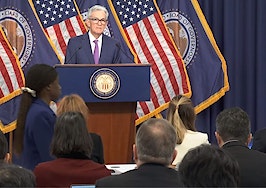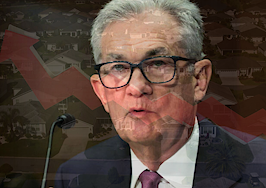Join the movement at Inman Connect Las Vegas, July 30 – Aug. 1! Seize the moment to take charge of the next era in real estate. Through immersive experiences, innovative formats, and an unparalleled lineup of speakers, this gathering becomes more than a conference — it becomes a collaborative force shaping the future of our industry. Secure your tickets now!
Federal Reserve policymakers left short-term interest rates unchanged Wednesday but indicated they still envision cutting the federal funds rate three times this year, by a total of three-quarters of a percentage point as previously forecast in December.
For those keeping a keen eye on mortgage rates, the other big news was that Fed Chair Jerome Powell said he and his colleagues are also considering slowing the pace of “quantitative tightening” — the unwinding of the central bank’s $7 trillion balance sheet.
To keep interest rates low during much of the pandemic, the Fed was buying $80 billion in long-term Treasury notes and $40 billion in mortgage-backed securities (MBS) every month, swelling its balance sheet to an unprecedented $8.5 trillion.
As inflation began to rage in 2022, the Fed not only began raising the federal funds rate to its current target of 5.25 percent to 5.5 percent but started trimming its balance sheet by allowing up to $35 billion in maturing MBS and $60 billion in Treasury notes to roll off its books every month.
The Fed’s quantitative tightening has helped underpin mortgage rates, keeping them from falling more than they might have since peaking last year. With the Fed no longer competing in the market to buy government debt or mortgages, investors can demand higher returns.
“What we’re looking at is slowing the pace of runoff,” Powell said. “There isn’t much runoff in MBS right now, but there is in Treasurys, and we’re talking about going to a lower pace,” Powell said. “I don’t want to give you a specific number because we haven’t made an agreement or a decision. But that’s that’s the idea.”
In terms of the timing, Powell would only say that the slowdown will happen “fairly soon. I wouldn’t want to try to be more specific than that, but you get the idea.”
Rather than actively selling Treasurys and MBS, the Fed has been letting those investments roll off its balance sheet passively, by not replacing assets that mature.
But in recent months, that passive approach has only allowed the Fed to trim its MBS balance sheet by about $15 billion a month. Mortgage rates are still so high that few homeowners have an incentive to refinance their existing loans.
Fed unwinding its $7 trillion balance sheet
In a March 1 speech, Federal Reserve Governor Christopher Waller expressed frustration with the slow pace of the MBS rolloffs and said he’d like to see the Fed reduce its $2.4 trillion in MBS holdings to zero.
But achieving the Fed’s $35-billion-a-month MBS rolloff target would require it to abandon its passive strategy and start selling mortgages, which might push mortgage rates higher. Last fall, real estate industry groups urged Fed policymakers to publicly commit to not selling MBS.
“Our longer run goal is to return to a balance sheet that is mostly Treasurys,” Powell acknowledged of the desire to eventually unwind most of the Fed’s MBS holdings.
But it’s “not urgent right now” and, in the long run, tapering the pace of quantitative tightening could help the Fed make more progress in trimming its balance sheet by avoiding the kind of disruption that money markets experienced in 2019, he said.
“It’s sort of ironic that by going slower, you can get farther, but that’s the idea,” Powell said. “The idea is that with a smoother transition, you’ll run much less risk of liquidity problems, which can grow into shocks and which can cause you to stop the process prematurely.”
Yields on 10-year Treasury notes briefly spiked to 4.32 percent following the release of a statement by Fed policymakers that they did “not expect it will be appropriate” to cut short-term rates until they have “gained greater confidence that inflation is moving sustainably toward 2 percent.”
But the 10-year Treasury yield, a barometer for mortgage rates, quickly retreated to 4.27 percent as investors digested the “dot plot” in the latest Summary of Economic Projections indicating that policymakers still envision cutting rates three times this year.
Futures markets tracked by the CME FedWatch Tool on Wednesday put the odds of a June rate cut at 74 percent, and investors were pricing in a 43 percent chance that the Fed will make four or more rate cuts by the end of the year.
In a note to clients, Pantheon Macroeconomics Chief Economist Ian Shepherdson said forecasters at the firm still expect five rate cuts totaling 1.25 percentage points this year, beginning in June.

Ian Shepherdson
“We are encouraged by policymakers’ decision to stick with three rate cuts this year and to forecast a markedly slower run rate in core inflation across the remainder of the year,” Shepherdson wrote. “We’d now like to hear from Chair Powell if these decisions reflect increasing signs of softening in the economy, visible in the recent retail sales numbers, sharply lower hiring intentions … and an array of indicators pointing to rising layoffs in the spring.”
In a forecast released Tuesday, economists at Fannie Mae said they no longer expect mortgage rates to drop below 6 percent this year or next, and that the recent surge in mortgage rates could diminish the strength of a projected rebound in 2024 home sales.
Get Inman’s Mortgage Brief Newsletter delivered right to your inbox. A weekly roundup of all the biggest news in the world of mortgages and closings delivered every Wednesday. Click here to subscribe.











